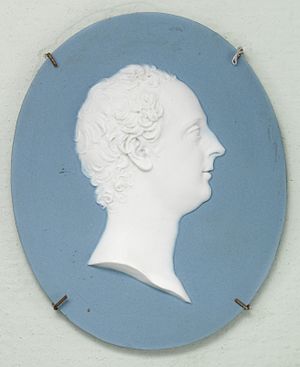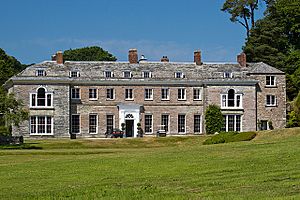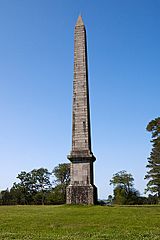Thomas Pitt, 1st Baron Camelford facts for kids
Quick facts for kids
The Lord Camelford
|
|
|---|---|

Wedgwood jasperware miniature, c. 1780
|
|
| Personal details | |
| Born | 3 March 1737 Boconnoc, Cornwall, England |
| Died | 19 January 1793 (aged 55) Florence, Italy |
| Resting place | Boconnoc, Cornwall |
| Spouse |
Anne Wilkinson
(m. 1771) |
| Children | Thomas Pitt, 2nd Baron Camelford Anne Grenville, Baroness Grenville |
| Parents | Thomas Pitt of Boconnoc Christian Lyttelton |
| Relatives | William Pitt the Elder (uncle) |
| Alma mater | Clare College, Cambridge |
| Occupation | Politician |
Thomas Pitt, 1st Baron Camelford (born March 3, 1737 – died January 19, 1793) was an important British politician. He served in the House of Commons, which is like a main part of the British Parliament, from 1761 to 1784. Later, he was given a special title and became a Baron, which is a noble rank. Thomas Pitt was also known for his love of art and beautiful things.
Contents
Early Life and Adventures
Thomas Pitt was born in a place called Boconnoc in Cornwall, England, on March 3, 1737. His father was Thomas Pitt of Boconnoc, and his uncle was a very famous politician named William Pitt the Elder.
He went to Clare College, Cambridge, a well-known university, from 1754 to 1758. In 1759, he earned a special degree called a Master of Arts.
In 1760, Thomas Pitt went on an exciting trip. He traveled with the British ambassador to Portugal, then through Spain to Italy. He wrote a journal about his travels, describing things like a bullfight. While in Italy, he heard that his father had passed away. Thomas Pitt then made a big decision: he used his inheritance to pay off his father's debts and help his sisters. This showed he was a responsible and caring person.
A Career in Politics
When his father died, Thomas Pitt gained control over some special voting areas. These were called "rotten boroughs" because they had very few voters but a lot of power in Parliament. He became a Member of Parliament (MP) for Old Sarum from 1761 to 1768. Then he represented Okehampton from 1768 to 1774, and again Old Sarum from 1774 until 1784.
Pitt was involved in many political discussions. He worked with his relative, George Grenville, and even became a lord of the admiralty, which meant he helped manage the navy. He often disagreed with some of the powerful leaders of his time, like Lord North. He spoke out against things he thought were unfair, such as limiting the influence of the King.
In 1784, Thomas Pitt was given the noble title of Baron Camelford of Boconnoc. This was a big honor, partly because of his cousin, William Pitt the Younger, who was also a very important politician.
A Lover of Art and Architecture
Thomas Pitt was not just a politician; he also loved art and design. He lived in Twickenham, near London, and even called his house the 'Palazzo Pitti' as a fun reference to a famous palace in Florence, Italy.
He was very skilled in architecture, especially in the Gothic style. He helped design parts of famous buildings like Stowe House in Buckinghamshire. He was also a member of the Dilettanti Society, a group of people who loved and studied ancient art. He even tried to get them to create a public museum, but it didn't happen.
Pitt was interested in new inventions too. He helped a clockmaker named Thomas Mudge with his plans to improve nautical chronometers, which were important for telling time at sea. He also designed the wooden carvings for the stalls in Carlisle Cathedral.
Later Years
From 1789 to 1792, Thomas Pitt spent time in Italy. He returned to England briefly but went back to Europe in September 1792. He passed away in Florence, Italy, on January 19, 1793. He was buried back home in Boconnoc, where he had added new parts to his family's old house.
At Boconnoc, he also built a tall stone monument called an obelisk, which was 123 feet high. He built it in 1771 to remember his uncle, Sir Richard Lyttelton.
Family Life
In 1771, Thomas Pitt married Anne Wilkinson. She came from a wealthy family. They had two children:
- Thomas Pitt, who later became the 2nd Baron Camelford.
- Anne Pitt (born September 1772 – died 1864).
Thomas Pitt was known for being polite and sensible. He was also kind to his wife's sister and her children, helping them when they faced difficulties.
See also
- Conway's Bridge



